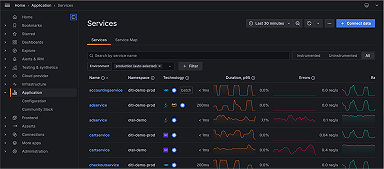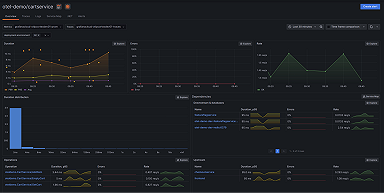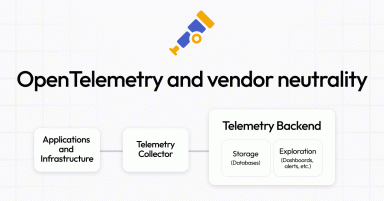
OpenTelemetry and Grafana Labs: What’s new and what’s next
A new year is a natural time to reflect on past achievements — and consider future aspirations.
When I think about the observability space, specifically, in 2023, OpenTelemetry felt omnipresent. It was a hot topic at every industry event, with at least one dedicated talk at ObservabilityCON, Monitorama, PromCon, and KubeCon + CloudNativeCon, both NA and EU. A notable highlight from KubeCon was OpenTelemetry going GA, marking a significant milestone in the project’s development.
The widespread recognition of OpenTelemetry signals strong market demand for its suite of offerings: the instrumentation API, SDKs, Collector, OTLP, and semantic conventions. OpenTelemetry’s vendor-neutral approach has been a significant draw, even though some aspects of the project could benefit from further maturity.
As both an OpenTelemetry project maintainer and a Grafanista, I’d like to revisit some of the biggest OTel advancements in 2023 and share some exciting projects on my personal bucket list for the year ahead.
Reflecting on OpenTelemetry milestones in 2023
Grafana Labs is fully committed to OpenTelemetry, and is actively engaged with the OTel community. In the past year or so, two key areas of focus have been interoperability with Prometheus and instrumentation SDKs — but there are certainly a lot of other advancements to celebrate.
Grafana Labs ❤️ OpenTelemetry
Embracing our big tent philosophy, we stepped up to support the OTel community with vendor-specific receivers for the OpenTelemetry Collector. This move helped community members who wanted to develop these components, but lacked a sponsor, especially as the relevant vendors showed little interest in supporting them.
The creation of a Loki Receiver, also in line with our big tent philosophy, demonstrated our commitment to aiding Promtail users in integrating with an OpenTelemetry Collector without overhauling their entire infrastructure.
In addition, drawing from our experiences with Pyroscope, we helped drive the proposals for OTel Profiling, and also committed to maintaining various OpenTelemetry Collector components, including the Load Balancing exporter, Tail Sampling processor, and most of the auth extensions.
In collaboration with the Prometheus community, specifically, we integrated OTLP support into the Prometheus Client for Java and Golang. And the other way around, as well: we helped include the Prometheus metrics client library into the OpenTelemetry Java SDK, as a native option to expose OTLP as Prometheus metrics. Prometheus is now all-in on OpenTelemetry, with significant work underway to make it a great OTel metrics backend. We also introduced an OTLP ingestion endpoint to ingest metrics.
And then, on a personal note, my reelection to the OpenTelemetry Governance Committee in the latter half of the year, bolstered by substantial community support, was definitely a 2023 highlight.
OTel within the Grafana ecosystem
As part of our commitment to the OTel project, we continue to focus on building compatibility into both our open source projects and products.
In 2023, we continued to develop the OTLP Gateway, enhancing its capability to ingest all three OTLP signals and ensuring their storage in our hosted services like Grafana Cloud Logs, Grafana Cloud Metrics, and Grafana Cloud Traces. As part of this effort, Grafana Cloud’s OTLP Endpoint just went GA this month!
We also unveiled Grafana Beyla, an innovative, open source eBPF-based auto-instrumentation project. Beyla can capture and export HTTP/gRPC telemetry for various languages, including C, C++, Go, and Rust.
Meanwhile, Grafana Agent, our distribution of OpenTelemetry Collector, now supports numerous OpenTelemetry Collector components. It’s tailored in areas we believe are crucial, like avoiding format conversions in Prometheus-to-Prometheus pipelines.
To simplify usage of OTel SDKs, we launched language distributions (or starters) for Java and .NET. These facilitate sending data to Loki, Mimir, and Tempo, or directly to Grafana Cloud.
And, speaking of Grafana Cloud, we also hit several milestones related to our fully managed platform, specifically: we launched Application Observability for Grafana Cloud, featuring native support for Prometheus and OpenTelemetry and a set of prebuilt Grafana dashboards natively integrated with your OpenTelemetry data. We also made progress towards ingesting OTLP in Grafana Cloud Logs. Stay tuned!

What’s on the horizon for OTel in 2024
Looking ahead, I’m filled with anticipation for our planned initiatives. While we might not accomplish everything by year’s end, the progress we’re set to make, both at Grafana Labs and within the wider OpenTelemetry community, is promising.
Areas of focus for the community
OTel community members are crafting a public 2024 roadmap for OpenTelemetry with a focus on stability, addressing a primary need of the community. Advancing client instrumentation is another key goal. We’re starting by refining the specification to allow context transmission back to callers, a vital feature for linking frontend and backend traces. In addition, renewed discussions around sampling might lead to advancements in the Collector’s capabilities in this area.
In partnership with the Prometheus community and through OTel’s Prometheus Working Group, we’re striving to make Prometheus v3 the best open source metrics database for OpenTelemetry data.
OTLP Profiles have also been extensively discussed and gone through the requirements of the “draft” stage; we anticipate significant progress as we move from “draft” to “experimental” status for profiling.
The ecosystem around OpenTelemetry is expanding rapidly, with tools like OTelBin gaining deserved community attention. We expect to see more tools emerging to enhance user experiences with our software.
What’s more, we know two areas, in particular — sustainability and generative AI — are a significant focus for everyone in the computing industry this year. Hopefully, we’ll be able to collaborate with the CNCF Environmental Sustainability TAG to raise awareness, establish semantic conventions about energy usage and carbon emissions per application, or gather metrics about our software to reduce the carbon footprint of OpenTelemetry users. We also foresee potential experiments involving LLMs and generative AI in the realm of instrumentations.
Lastly, a personal and vital goal: bringing more diversity into the OpenTelemetry community. While we’ve made strides in some areas, especially in our continued Outreachy mentorships, there’s significant room for improvement. It’s time for us to take concrete steps towards this essential objective.
Key objectives for Grafana Labs
Here at Grafana Labs, we know our work in Application Observability is just beginning, with many innovative ideas set to be implemented this year. Meanwhile, Grafana Beyla is on a fast track of development, likely to soon include support for first-class distributed traces.
We’re also working towards a more native approach to storing OTLP on Loki and Mimir, aiming to handle highly granular OTLP metadata without causing cardinality issues.
Overall, we’re really looking forward to continued collaboration and innovation within the OTel community in 2024!
To learn more about OpenTelemetry, you can check out our Application Observability documentation, as well as this comprehensive guide to OTel best practices.



